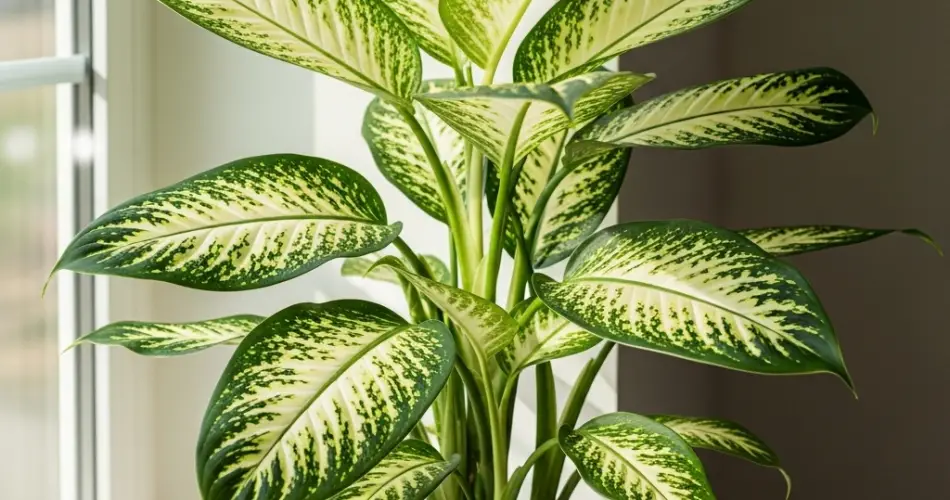Dieffenbachia, commonly known as dumb cane, is a popular indoor plant admired for its striking foliage and low-maintenance care. Its large, patterned leaves can brighten any room, making it a favorite among houseplant enthusiasts. However, Dieffenbachia is sensitive to environmental stressors such as drafts and pests. Protecting your plant from these threats is essential to maintain vibrant leaves, robust growth, and overall plant health. Understanding how to prevent and manage these issues ensures that your Dieffenbachia thrives indoors.
Understanding Dieffenbachia’s Environmental Needs
Dieffenbachia originates from tropical forests, where it grows under filtered sunlight and experiences stable temperature and humidity conditions. When grown indoors, replicating these conditions is key:
-
Temperature: Dieffenbachia thrives in temperatures between 65–75°F (18–24°C). Sudden temperature drops can stress the plant.
-
Humidity: Moderate to high humidity (around 50–60%) supports healthy foliage. Dry indoor air can lead to brown leaf edges and stunted growth.
-
Light: Bright, indirect light encourages vibrant leaf coloration. Direct sunlight can scorch leaves, while low light slows growth.
Drafts and fluctuating temperatures are particularly harmful because they disrupt the plant’s ability to absorb water and nutrients efficiently.
Protecting Dieffenbachia from Drafts
Indoor drafts can occur near windows, doors, air conditioning vents, or heating units. These drafts can cause leaf curling, yellowing, or dropping. Here’s how to protect your plant:
-
Choose a stable location: Place Dieffenbachia away from windows and doors that frequently open, or areas near HVAC vents.
-
Use barriers: Consider using curtains, screens, or furniture as a shield against cold or hot air currents.
-
Monitor temperature: Avoid sudden temperature fluctuations. If your home experiences drafts in winter, move the plant to a warmer, more stable spot.
-
Elevate the plant: Placing the plant slightly above floor level can reduce exposure to cold drafts that often settle near the ground.
Creating a consistent microenvironment helps prevent stress and keeps foliage healthy.
Preventing and Managing Pests
Dieffenbachia is susceptible to common indoor pests such as spider mites, mealybugs, scale, and aphids. Early detection and prevention are crucial:
-
Regular inspection: Check leaves, stems, and undersides regularly for small insects or webbing.
-
Quarantine new plants: Isolate any new plants for a few weeks before introducing them to your indoor garden to prevent pest infestation.
-
Maintain cleanliness: Wipe leaves with a damp cloth to remove dust, which can harbor pests. Keep the surrounding area clean and free of plant debris.
-
Use natural remedies: For minor infestations, a diluted solution of water and mild soap or neem oil can effectively remove pests.
-
Chemical treatments: If infestations are severe, select indoor-safe insecticides according to the label instructions, ensuring the plant is not exposed to excessive chemicals.
Consistent monitoring and preventive measures help reduce the likelihood of pest-related damage.
Optimizing Overall Plant Health
Healthy plants are naturally more resilient to drafts and pests. Key care practices include:
-
Watering appropriately: Maintain even soil moisture without waterlogging. Allow the top inch of soil to dry slightly between waterings.
-
Fertilizing regularly: Use a balanced, water-soluble fertilizer every 4–6 weeks during the growing season to support strong roots and foliage.
-
Maintaining humidity: Group plants together or use a humidity tray to maintain adequate moisture levels.
-
Pruning: Remove yellow or damaged leaves to redirect energy to healthy growth and improve airflow around the plant.
Strong, well-cared-for Dieffenbachia plants are less vulnerable to stress and more capable of resisting pests.
Signs of Stress from Drafts or Pests
-
Leaf yellowing or curling: Often caused by cold drafts, fluctuating temperatures, or inconsistent watering.
-
Leaf drop: Can indicate prolonged exposure to drafts or severe pest infestation.
-
Sticky residue or webbing: Sign of aphids or spider mites.
-
Brown spots or edges: May result from dry air, draft exposure, or fungal issues linked to pests.
Recognizing these signs early allows timely intervention and helps preserve plant health.
Final Thoughts
Protecting Dieffenbachia from drafts and pests is essential for maintaining its lush foliage and indoor appeal. By placing the plant in a stable environment, monitoring for pests, and practicing consistent care—including proper watering, fertilization, and humidity management—you can ensure your Dieffenbachia thrives indoors.
Proactive attention to environmental stability and pest prevention allows your Dieffenbachia to remain a vibrant, healthy centerpiece in your indoor garden, offering lush, patterned leaves and long-lasting beauty for years to come.



